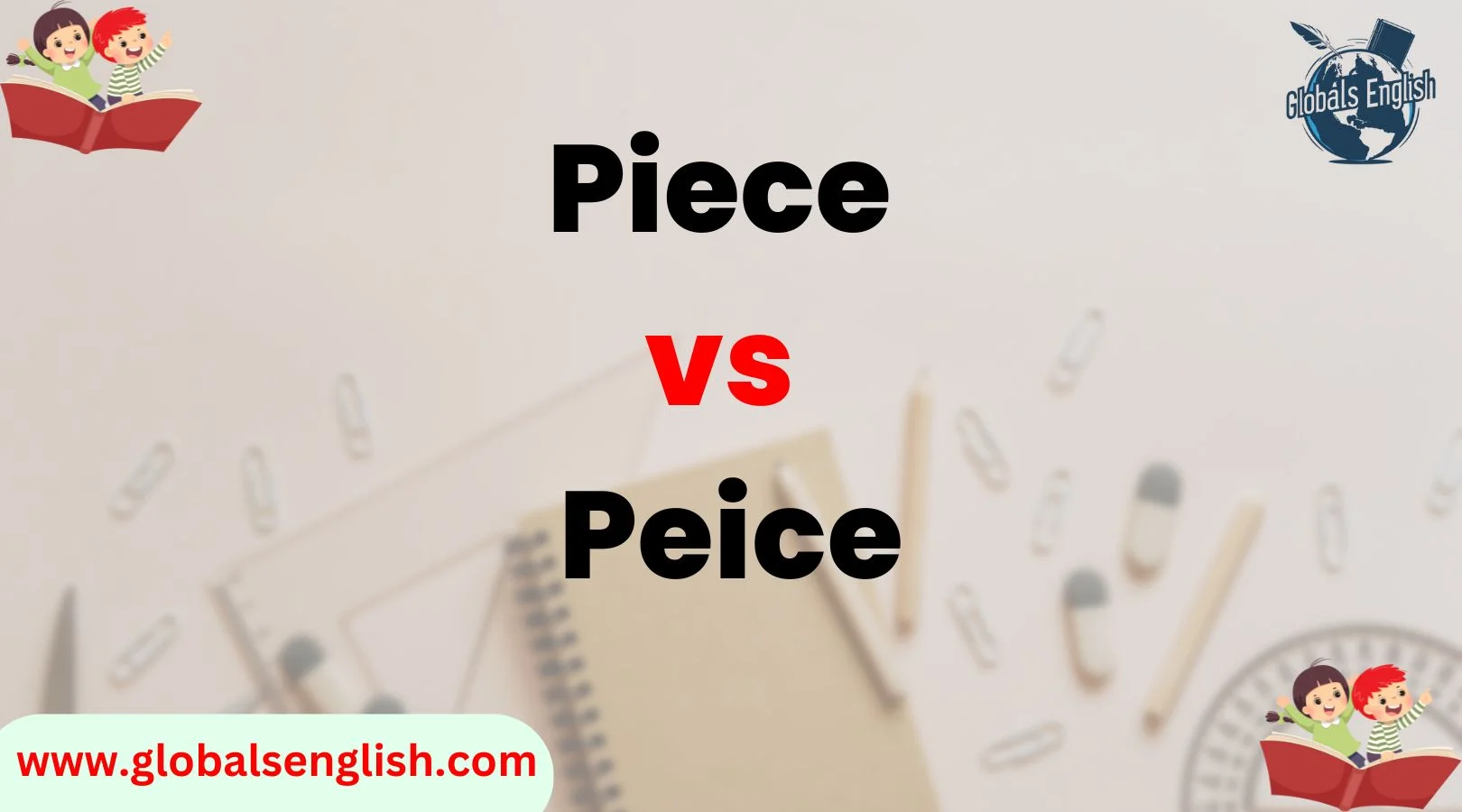When it comes to spelling, English can be a tricky language, and one of the most common pitfalls is the confusion between “piece” and “peice.” You’ve likely come across both of these spellings, and you might wonder which one is correct.
Is it “piece,” like a portion of something, or “peice,” a variant that looks like it could work?
Rest assured, “piece” is the only correct spelling, and we’ll explain why. In this article, we’ll dive deep into why this confusion occurs, the history of the word, and how you can avoid this common mistake in your own writing.
By the end of this post, you’ll be confident in your ability to spell “piece” correctly every time. So, let’s clear up the confusion once and for all!
The Meaning of “Piece”
Before we dive into the common confusion between “piece” and “peice,” let’s first explore what “piece” actually means. A “piece” refers to a part or portion of a whole. It can describe anything from a segment of food to a portion of something larger, like a puzzle piece or a work of art.
The versatility of the word “piece” makes it a crucial part of the English language, showing up in various contexts from everyday conversation to literature.
Here are a few examples of how “piece” is used:
- Piece of cake: This phrase refers to something that is very easy to do.
- Piece of the pie: Used metaphorically, it means a share of something, often related to money or responsibility.
- A piece of art: Refers to a specific creation, like a painting or sculpture.
- A chess piece: In the context of games, it refers to one of the individual items used in playing chess.
As you can see, “piece” has a wide range of uses, all relating to parts or segments of a larger entity. Its versatility and simple structure make it a word that is frequently used in everyday communication.
The Mistaken Spelling: “Peice”
Now that we understand the meaning of “piece,” let’s address the most common mistake: spelling it as “peice”. This error often arises because of the confusion between “ei” and “ie” combinations. Many people mistakenly think the correct form is “peice,” probably because it sounds somewhat similar to other words like “niece” or “receive”—both of which use the “ei” combination.
However, English spelling rules don’t allow “peice” in this case, and using it can undermine the credibility of your writing.
Why does this happen? Well, the “ie” combination in words like “piece” often causes confusion for those who may have heard the word more than seen it written. The error may come from the way the word is pronounced or from a mental habit of assuming “ei” is more common, especially in words like “receive.”
This mistake is so widespread that even spellcheck tools sometimes don’t catch it in quick, informal writing. However, when you need to maintain professionalism or accuracy in your writing, spelling it correctly matters.
Example of “Peice” Misuse:
You might see something like this in a sentence: “I bought a peice of cake for lunch.” This is a clear indication that the writer mixed up the spelling. While the reader understands what is meant, the incorrect spelling could cause the writing to appear rushed or unpolished.
The History of “Piece”
To better understand why “piece” is spelled the way it is, let’s take a historical look at its evolution. The word “piece” traces its roots to the Middle English term “pese” (spelled in a variety of ways, such as “pece” or “pes”), which was borrowed from Old French “piece.”
In both of these languages, it carried a similar meaning, referring to a part or portion of something. The spelling, however, evolved over time, particularly as the standardization of English grew in the 15th and 16th centuries.
The shift from “peice” to “piece” follows the natural trend of English orthography, which developed rules based on phonetic sounds and Latin influence.
As spelling systems became more consistent, the “ie” combination became more common for words with this specific pronunciation.
It’s important to note that English spelling was not standardized until the late 17th century. Before dictionaries were widespread, people often wrote words the way they sounded.
As printing became more prevalent, standard dictionaries helped consolidate spellings, but inconsistencies like “peice” still pop up due to variations in how people speak and hear words.
Why “Peice” Is Incorrect
The main reason “peice” is incorrect lies in spelling rules and historical consistency. According to established patterns in English, the combination “ie” generally appears before “c,” as in “piece” and “believe.”
On the other hand, the “ei” combination is more commonly seen when it follows the letter “c,” such as in “receive” or “ceiling.”
Thus, “peice” doesn’t align with orthographic conventions in English, making it an incorrect spelling. It’s important to remember that English spelling follows specific rules that, though sometimes confusing, make language consistent and recognizable.
When we break these rules, we risk introducing unnecessary confusion, especially in formal writing or communication.
The Influence of Pronunciation on Spelling
One of the reasons “peice” feels like a plausible alternative to “piece” is because of how the word is pronounced. In spoken English, the “ie” sound is quite similar to the “ei” sound. So, when people hear the word, they might subconsciously believe that the “ei” spelling is correct. This is particularly true in rapid speech or informal settings, where pronunciation takes precedence over exact spelling.
The sound of “piece” is /piːs/, which is often pronounced quickly and casually, making it harder for some people to recall the precise spelling. The “ee” sound in “piece” leads many to mistakenly spell it as “peice,” thinking that the “ei” rule applies in this case.
Common Scenarios Where “Peice” Appears
Despite the clear rule about spelling “piece” correctly, the error “peice” still appears frequently in writing, particularly in informal settings. You’ll likely encounter it in social media posts, casual emails, and texts.
These mistakes can be especially common when people type quickly and rely on autocorrect or predictive text features, which sometimes miss subtle errors.
In professional or academic writing, however, misspelling “piece” as “peice” can negatively affect your credibility. It may give the impression of carelessness or a lack of attention to detail.
That’s why it’s important to be diligent in proofreading your work, even if you’re typing on your phone or in a hurry.
Quick Memory Tips to Avoid “Peice”
Now that we’ve explored the reasons behind this confusion, let’s look at a few simple tips to help you avoid the mistake of spelling “piece” as “peice.”
Visual Reminders
One of the easiest ways to avoid misspelling “piece” is to create a visual reminder in your mind. Picture a puzzle piece—you’ve seen these before, and they always come in the shape of “ie” before the “c.” This visual cue can help you recall the correct spelling when you need it most.
Mnemonics
Another great way to remember the correct spelling is through mnemonics. For example, try this: “I before E except after C, and that’s how you spell piece.” The famous rhyme for “ie” and “ei” combinations can help reinforce the rule. You could also create your own memory aid that fits your learning style.
How to Use “Piece” Correctly
Once you know how to spell “piece” correctly, it’s just as important to understand when to use it. “Piece” is a versatile word that can be used in many contexts. Here are a few examples:
When “Piece” Refers to a Portion
When you want to describe a part of something larger, use “piece.” For example:
- “She gave me a piece of cake.”
- “We need one more piece of evidence.”
When “Piece” Is a Part of Something Larger
“Piece” can also refer to something that’s a component of a whole, like:
- “He added another piece to his collection.”
- “That’s an important piece of the puzzle.”
Common Mistakes in Similar Words
It’s not just “piece” and “peice” that cause confusion in English. Many words with similar “ie” and “ei” combinations can be tricky. Words like “peace,” “pier,” and “peel” all have different spellings, even though they sound similar.
Understanding the distinctions between them can help improve your overall spelling skills.
Why English Spelling is Tricky and How to Overcome It
English spelling is notoriously difficult due to its rich history and the many languages that have influenced it. From Latin to French to Old English, spelling has evolved in ways that can make it hard to predict.
However, with consistent practice and tools like spellcheckers, you can avoid most common mistakes.
Reading regularly, paying attention to the rules, and using writing apps or grammar checkers are all great ways to improve your spelling and writing skills over time.
Frequently Asked Questions (FAQs)
1. Is it ever correct to use “peice” instead of “piece”?
No, “peice” is never correct. The proper spelling is always “piece” when referring to a part or portion of something. “Peice” is a common misspelling that results from confusion between the “ie” and “ei” combinations.
2. Why do people often confuse “piece” with “peice”?
The confusion often arises because both words are pronounced similarly. The “ie” and “ei” combinations in English can be tricky, and the incorrect spelling “peice” often results from thinking of other words like “niece” or “receive,” which use the “ei” combination. However, “piece” follows the established “ie” rule before “c.”
3. How can I remember the correct spelling of “piece”?
A simple mnemonic to help you remember the correct spelling is: “I before E, except after C.” This rule works for most words with the “ie” combination, including “piece.” You could also think of a puzzle piece to remind you that it’s always “ie” before “c.”
4. Does autocorrect make the mistake of using “peice”?
Yes, autocorrect can sometimes make this mistake, especially in informal writing or when you’re typing quickly. It’s important to review your writing carefully, even if autocorrect doesn’t catch the error. Using spellcheck or grammar tools can help catch it before you hit send or submit.
5. Can “piece” be used in different contexts?
Yes, “piece” is a versatile word that can be used in many different contexts. It can refer to:
- A portion of something (e.g., “a piece of cake”).
- A part of a larger whole (e.g., “a piece of artwork”).
- A specific item in a set (e.g., “a chess piece”).
Conclusion
In the end, “piece” is the correct spelling when you’re referring to a portion or part of something. The confusion with “peice” is common, but now that you understand the rules and reasons behind it, you’ll never make that mistake again.
Whether you’re writing emails, essays, or social media posts, keeping these tips in mind will ensure that your spelling remains accurate and professional. With a little practice and attention to detail, you can master English spelling and continue communicating with confidence.

Mia Rose are the minds behind Globals English, a platform dedicated to making English learning simple, engaging, and effective. With a shared passion for education and communication, they bring years of experience in language teaching and curriculum development.
